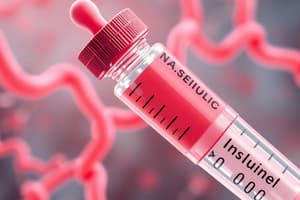Podcast
Questions and Answers
Which of the following processes occurs in the Golgi apparatus during insulin production?
Which of the following processes occurs in the Golgi apparatus during insulin production?
- Initial folding of proinsulin and disulfide bond formation.
- Storage of insulin hexamers in secretory granules.
- Cleavage of C-peptide from proinsulin to form active insulin. (correct)
- mRNA translation into preproinsulin.
What is the primary role of C-peptide in insulin production?
What is the primary role of C-peptide in insulin production?
- Stabilizing the structure of proinsulin through disulfide bond formation. (correct)
- Facilitating the transport of glucose into cells.
- Triggering the exocytosis of insulin from the beta cells.
- Inhibiting the production of ketone bodies.
Which step directly leads to the depolarization of the beta cell membrane during insulin secretion?
Which step directly leads to the depolarization of the beta cell membrane during insulin secretion?
- Influx of calcium ions through voltage-gated channels.
- Closure of ATP-sensitive potassium channels. (correct)
- Production of ATP via glycolysis.
- Entry of glucose into the beta cell.
How does insulin primarily facilitate glucose uptake in muscle and fat cells?
How does insulin primarily facilitate glucose uptake in muscle and fat cells?
Which of the following metabolic processes is directly inhibited by insulin in the liver?
Which of the following metabolic processes is directly inhibited by insulin in the liver?
Why does polyuria occur in individuals experiencing hyperglycemia?
Why does polyuria occur in individuals experiencing hyperglycemia?
In diabetic ketoacidosis, what directly leads to the buildup of ketones in the blood?
In diabetic ketoacidosis, what directly leads to the buildup of ketones in the blood?
How does high glucose contribute to nephropathy in diabetic patients?
How does high glucose contribute to nephropathy in diabetic patients?
What is the primary immunological mechanism behind Type 1 Diabetes Mellitus (T1DM)?
What is the primary immunological mechanism behind Type 1 Diabetes Mellitus (T1DM)?
In Type 2 Diabetes Mellitus (T2DM), what is the initial compensatory mechanism that eventually fails, leading to hyperglycemia?
In Type 2 Diabetes Mellitus (T2DM), what is the initial compensatory mechanism that eventually fails, leading to hyperglycemia?
Flashcards
Insulin
Insulin
A hormone produced by the islet cells in the pancreas that lowers blood glucose levels.
Ribosome
Ribosome
The process where mRNA encoding preproinsulin is processed.
Rough Endoplasmic Reticulum (ER)
Rough Endoplasmic Reticulum (ER)
The location where mRNA is translated into preproinsulin; single peptide is removed forming proinsulin.
C-Peptide
C-Peptide
Signup and view all the flashcards
Golgi Apparatus
Golgi Apparatus
Signup and view all the flashcards
Insulin Secretion Mechanism
Insulin Secretion Mechanism
Signup and view all the flashcards
GLUT4 Translocation
GLUT4 Translocation
Signup and view all the flashcards
Polyuria
Polyuria
Signup and view all the flashcards
Ketoacidosis
Ketoacidosis
Signup and view all the flashcards
Type 1 Diabetes Mellitus (T1DM)
Type 1 Diabetes Mellitus (T1DM)
Signup and view all the flashcards
Study Notes
- Endocrine Disorders - Diabetes involves issues with insulin production or action.
Diabetes and the Pancreas
- Diabetes is characterized by a deficiency of insulin or when the body cannot use insulin efficiently.
- The pancreas contains islet cells that produce insulin.
- Insulin helps lower blood sugar/glucose levels.
Physiology of Insulin Production
- The process begins with mRNA encoding preproinsulin being processed in the ribosome.
- In the rough ER, mRNA is translated to preproinsulin, and a single peptide is removed to form proinsulin.
- Proinsulin folding occurs in the rough ER.
- A and B chains become disulfide bonded, stabilizing the structure and measuring insulin release.
- In the Golgi apparatus, converting enzymes cleave Peptide C, resulting in active insulin.
- Active insulin and C-Peptide + A/B chains disulfide bonded are stored in secretory granules as hexamers.
- Insulin is released more slowly from its storage form.
- Glucose triggers Ca2+ influx in beta cells, causing insulin exocytosis.
Insulin Secretion Process in Beta cells
- Glucose enters beta cells to initiate insulin secretion.
- Glycolysis intracellularly produces pyruvate.
- Pyruvate enters mitochondria and ATP is then produced.
- ATP-sensitive K+ channels close, preventing K+ from leaving the cell.
- The cell is depolarized as a result.
- Voltage-gated Ca2+ channels open, allowing Ca2+ to enter the cell.
- Increased Ca2+ levels trigger insulin exocytosis.
Insulin Secretion – Glucose Stimulated
- With increased levels Glucose-Glucose-6P, glycolysis occurs, which produces pyruvate.
- That pyruvate enters the mitochondria and ATP is produced.
- An increase in ATP causes ATP-sensitive K+ channels to close, trapping K+ inside the cell, which leads to depolarization.
- Ca2+ channels in the cell open, leading to exocytosis.
Insulin Signaling Pathways
- Insulin binds to a tyrosine kinase receptor.
- GLUT 4 then inserts into the membrane, which allows glucose to enter.
- GLUT 4 translocates to muscle or fat cells after someone exercises, or after eating a meal.
GLUT 4 Translocation
- Insulin binds to the tyrosine kinase receptor.
- Then GLUT 4 inserts into the membrane which then allows glucose entry.
- GLUT 4 then translocates into muscle or fat cells after exercise or eating.
- GLUT 4 is found within fat and muscle tissues and needs a glucose transporter.
Effects of Insulin at the Liver
- Glycogen synthesis, storage of glucose are increased, while gluconeogenesis and glucose production is inhibited.
- Fat production via lipogenesis is increased
- Glycolysis is increased
- Glucose breakdown to make ATP is increased.
- Protein metabolism is increased
- Proteins break down into amino acids using insulin
- Glucose 4 Transporters don't work there.
Effects of Insulin at Fat/Adipose Tissue
- Glucose uptake is stimulated via GLUT 4 transporters.
- Glycolysis; glucose breakdown to make ATP, and fat production via lipogenesis are stimulated.
- Esterification, the attaching of fatty acids to form triglycerides, is increased.
- The production of glucose is inhibited,.
Effects of Insulin on Muscle Cells
- Glucose uptake is stimulated via GLUT 4 transporter.
- Glycogen synthesis and glucose storage are increased.
- Glycolysis, the glucose breakdown to make ATP is increased
- Protein metabolism and the use of amino acids for protein synthesis are increased.
Coordinated Glucose Control
- Insulin lowers blood glucose.
- Blood glucose is released from the liver.
- Adipose tissue and muscles consume blood glucose.
- Counter-regulatory hormones influence blood glucose
- Glucagon, epinephrine, norepinephrine, glucocorticoids and growth hormones increase blood glucose levels
Diabetes Mellitus
- Characterized by hyperglycemia due to the inability to use or store glucose.
- Type 1 results from the inability to make insulin
- Type 1 diabetes accounts for 3-5% of cases and involves autoimmune destruction of beta cells.
- In type 1 diabetics, no insulin is made, but people can still respond to treatment.
- Type 2 diabetes accounts for 90-95% of cases and is more prevalent.
- Type 2 diabetes is a resistance to insulin actions in peripheral tissues, muscle, fat, and liver, resulting in insulin resistance.
- There are defects in insulin secretion, especially given a glucose stimulus, and increased glucose production by the liver.
Blood Test Levels for Diagnosis of Diabetes and Prediabetes
| Category | A1C (percent) | Fasting Plasma Glucose (mg/dL) | Oral Glucose Tolerance Test (mg/dL) |
|---|---|---|---|
| Diabetes | 6.5 or above | 126 or above | 200 or above |
| Prediabetes | 5.7 to 6.4 | 100 to 125 | 140 to 199 |
| Normal | About 5 | 99 or below | 139 or below |
Complications/Symptoms of Hyperglycemia
- Acute symptoms are polyuria (excessive urine), polydipsia (excessive thirst), polyphagia (excessive hunger), fatigue, and blurred vision.
- Chronic complications are, neuropathy (nerve damage), nephropathy (kidney damage), retinopathy (eye damage), and increased risk of cardiovascular disease.
- Hyperglycemia affects multiple organ systems.
- In adipose tissue, it decreases insulin-dependent glucose uptake, increases lipolysis, decreases adiponectin, and increases leptin and resistin. Macrophage accumulation and inflammation occur, which lead to TNF-a, IL-6 release.
- In the liver, hepatic gluconeogenesis increases.
- In the digestive system, GLP-1 and GIP decrease, as does stomach secretion of ghrelin.
- The kidneys: Increased glucose reabsorption and gluconeogenesis.
- In the muscles: There is less insulin sensitivity and glucose uptake, in addition to more lipid accumulation
- Pancreas: The secretion of both B-cell insulin and amylin is reduced coupled with an increase in A-cell glucagon secretion
Consequences of Hyperglycemia
- Chronic hyperglycemia can cause:
- eyes ( Retinopathy and cataracts).
- nervous system and brain: (neurotransmitter dysfunction, lipid sensing, neuropathy).
- cardiovascular: (hypertension, PVD, stroke, heart disease).
- liver and digestive: (Steatohepatitis, Gastroparesis, Biliary disease)
- kidneys: (Nephropathy, Glomerulosclerosis, Chronic kidney disease)
- Chronic hyperglycemia can also lead to decreased cognition, oxidative stress, immunosuppression/infection, and cancer.
Type I Diabetes: Untreated
- With insulin deficiency, glucose uptake by cells decreases and hepatic glucose output increases.
- Not using glucose leads to hyperglycemia and glucosuria.
- Water is drawn into the urine, resulting in osmotic diuresis, polyuria, dehydration, and cellular shrinking.
- Low blood volume, peripheral circulatory failure, and renal failure can occur, leading to death
- Decreased triglyceride synthesis and increased lipolysis lead to higher levels of blood fatty acids and ketoacidosis
- Ketonemia serves as an alternative energy source, with ketosis leading to metabolic acidosis and increased ventilation to the liver.
- There is decreased amino acid uptake by cells and increased protein degradation, leading to increased blood amino acids, muscle wasting and weight loss.
- Gluconeogenesis in the liver becomes is aggravated,
Why Ketoacidosis Occurs
- Ketoacidosis occurs due to a lack of enough insulin.
- Glucose can't enter cells for energy, so the body starts breaking down fat for fuel, which produces ketones that accumulate in the blood.
DKA and HHNKS
- With hyperglycemia from relative insulin insufficiency, a precipitating factor increases stress hormones while decreasing insulin use and glucose production.
- Profound lipolysis results in the formation of beta-hydroxybutyric and acetoacetic acids (free fatty acids), leading to diabetic ketoacidosis (DKA). Ketones are then found in the urine. It also produces Kussmaul respirations.
- Moderate lipolysis leads to hyperosmolality, solute diuresis, polyuria, and dehydration, which depresses the central nervous system, also called hyperosmolar hyperglycemic nonketotic syndrome (HHNKS).
Nephropathy
- High glucose can damage glomeruli, leading to protein leaking into the urine and ultimately kidney failure.
Glomerulopathy
- With Renal blood flow, it leads glomerular hypertension, mesangial cells expanding, thickening, and broadening of foot processes which leads to protein loss.
- Kidney tubule issues lead to tubulopathy, including renal interstitial issues. Reduced kidney function results from renal vasodilation, decreased GFR and albumin loss.
Pathology, potential amputation
- Retinopathy weakens blood vessels in the retina, causing hemorrhage and retinal ischemia, the damage to nerve function and the loss of sensation, increases the incident for injury which leads to poor circulation and an infection risk caused by wounds.
- Gangrene is also possible caused by damage blood vessels.
Neuropathy
- Damages nerves which decreases nerves and nerve function.
- Damaged vessels can cause angiopathy
- With large vessels, there are macrovascular diseases.
- With small vessels, there is neuropathy.
- Neuropathy includes sensory and motor impairments
Type 1 Diabetes
- Autoimmune destruction of pancreatic beta cells is driven by the activation of cellular and humoral immunity toward beta cells, resulting in a decrease in insulin secretion and eventual cellular starvation.
- T cells attack beta cells and there is no insulin production, so absolute insulin deficiency results with cells starve
Type 2 Diabetes
- Likely caused by by genetic predisposition.
- insulin resistance and B-cell dysfunction which is varies amongst individuals
- It is influenced by environmental factors such as obesity which effects insulin receptors, and that lowers beta cell mass and function.
- Which leads to glucose not responding and an insulin deficiency.
Studying That Suits You
Use AI to generate personalized quizzes and flashcards to suit your learning preferences.




